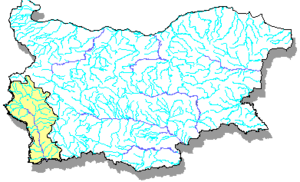Struma (river) facts for kids
Quick facts for kids Struma (Струма), Strymónas (Στρυμόνας) |
|
|---|---|

The course of the Struma in Bulgaria and Greece (marked in red)
|
|
| Countries | Bulgaria and Greece |
| Physical characteristics | |
| Main source | The south slopes of Vitosha, Bulgaria 2,180 m (7,150 ft) |
| River mouth | North Aegean Sea, Greece 40°47′9″N 23°50′56″E / 40.78583°N 23.84889°E |
| Length | 415 km (258 mi) |
| Basin features | |
| Basin size | 17,330 km2 (6,690 sq mi) |
The Struma or Strymónas is an important river that flows through Bulgaria and Greece. In ancient times, it was known as Strymṓn. This river's basin, which is the land area that drains into it, covers about 17,330 square kilometers. Most of this area is in Bulgaria (8,670 km²) and Greece (6,295 km²). Smaller parts are in North Macedonia and Serbia.
The Struma River begins high up in the Vitosha Mountain in Bulgaria. It first flows west, then turns south, carving out many deep valleys called gorges. It enters Greece near the village of Promachonas in eastern Macedonia. In Greece, the river is very important for Lake Kerkini, a special place for many migratory wildfowl (birds that travel long distances). The river then flows through the Serres region in Greece and empties into the Strymonian Gulf in the Aegean Sea, close to the ancient city of Amphipolis.
The Struma River is about 415 kilometers long. About 290 kilometers of its length are in Bulgaria, making it the fifth-longest river in that country. It is also one of the longest rivers that stays entirely within the Balkans region.
The river valley in Bulgaria used to be a big area for coal mining. Today, the southern part of the Bulgarian section is known for its wine production. In Greece, the Struma valley is a large farming area, being the fourth-biggest valley in the country. Many smaller rivers flow into the Struma, including the Konska River, the Dragovishtitsa, the Rilska River, the Blagoevgradska Bistritsa, the Sandanska Bistritsa, the Strumitsa, the Pirinska Bistritsa, and the Angitis.
Contents
River Name: What Does Struma Mean?
The name of the Struma River comes from an old Thracian word, Strymón. This word is linked to a very old language called Proto-Indo-European, where *srew- meant 'stream'. You can see similar words in other languages today, like the English word stream. Other examples include the Old Irish word sruaimm (meaning 'river') and the Polish word strumień (meaning 'stream').
In ancient Greek mythology, Strymón was also the name of a mythical Thracian king. Legend says he drowned in the river. The name Strymón was also used as a personal name for people in different parts of Ancient Greece around 300 BC.
Today, in the Macedonian language, the river is called Струма. In Turkish, it is known as Karasu, which means 'black water'.
A Look Back: History of the Struma River
The Struma River has played a part in many historical events.
Ancient Times and Important Cities
In 437 BC, the ancient Greek city of Amphipolis was built near where the river flows into the Aegean Sea. This spot was once called Ennea Hodoi, meaning 'Nine roads'.
A famous story tells that in 480 BC, when Xerxes I of Persia crossed the Struma River during his invasion, he made a sacrifice. He buried nine young boys and nine young girls alive to honor the river god. Later, in 479 BC, the army of Alexander I of Macedon defeated the remaining Persian forces near Ennea Hodoi.
In 424 BC, a Spartan general named Brasidas traveled across Greece and captured Amphipolis. Ancient writings suggest that the river was easy to travel by boat from its mouth all the way up to an old lake called Cercinitis (which is now dry). This made the Struma an important waterway for trade and travel between the coast and the inland areas, almost reaching the city of Serres.
Battles and Conflicts
A very important battle, the Battle of Kleidion, happened near the river in 1014. This battle was between the Bulgarians, led by Emperor Samuel, and the Byzantines, led by Emperor Basil II. The Byzantines won, and this led to the fall of the First Bulgarian Empire four years later.
In 1913, during the Second Balkan War, the Greek Army was almost trapped by the Bulgarian Army in the Kresna Gorge of the Struma. This forced the Greeks to ask for a ceasefire.
The Struma river valley was also part of the Macedonian front during World War I.
A Ship's Sad Story
The ship Struma was named after this river. In World War II, this ship carried Jewish refugees from Romania. Sadly, it was torpedoed and sunk in the Black Sea, causing the deaths of nearly 800 people.
Honour
- Struma Glacier on Livingston Island in the South Shetland Islands, Antarctica is named after Struma River.
Images for kids
-
The ancient Persian fort at Eion (left) and the mouth of the Strymon River (right), seen from Ennea Hodoi (Amphipolis)





